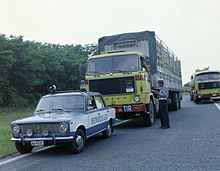| Convention on International Transport of Goods Under Cover of TIR Carnets | |
|---|---|
 Contracting Parties to the TIR Convention Contracting Parties to the TIR Convention | |
| Signed | 14 November 1975 |
| Location | Geneva |
| Effective | 20 March 1978 |
| Condition | 5 ratifications |
| Signatories | 17 |
| Parties | 77 |
| Depositary | Secretary-General of the United Nations |
| Languages | English, French and Russian |



The Convention on International Transport of Goods Under Cover of TIR Carnets (TIR Convention) is a multilateral treaty that was concluded at Geneva on 14 November 1975 to simplify and harmonise the administrative formalities of international road transport. (TIR stands for "Transports Internationaux Routiers" or "International Road Transports".) The 1975 convention replaced the TIR Convention of 1959, which itself replaced the 1949 TIR Agreement between a number of European countries. The conventions were adopted under the auspices of the United Nations Economic Commission for Europe (UNECE). As of December 2020, there are 77 parties to the Convention, including 76 states and the European Union.
The TIR Convention establishes an international customs transit system with maximum facility to move goods:
- in sealed vehicles or containers;
- from a customs office of departure in one country to a customs office of destination in another country;
- without requiring extensive and time-consuming border checks at intermediate borders;
- while, at the same time, providing customs authorities with the required security and guarantees.
The TIR system not only covers customs transit by road, but a combination is possible with other modes of transport (e.g., rail, inland waterway, and even maritime transport), as long as at least one part of the total transport is made by road.
To date, more than 33,000 international transport operators had been authorised (by their respective competent national authorities) to access the TIR system, using around 1.5 million TIR carnets per year.
In light of the expected increase in world trade, further enlargement of its geographical scope and the forthcoming introduction of an electronic TIR system (so-called "eTIR-system"), it is expected that the TIR system will remain the only truly global customs transit system.
Due to the large blue-and-white TIR plates carried by vehicles using the TIR convention, the word "TIR" entered many languages, such as Italian, Polish, Portuguese, Romanian or Turkish, as a neologism, becoming the default generic name of a large lorry.
Saudi Arabia acceded to the convention on 17 May 2018, and the convention entered into force for Saudi Arabia on 17 November 2018. Egypt acceded to the convention on 16 December 2020, and entered into force in Egypt on 16 June 2021.
With the accession of Saudi Arabia and Egypt, the TIR Convention had seventy-seven Contracting Parties.
TIR procedures
Hauliers making use of the TIR procedure must first obtain an internationally harmonised customs document, referred to as a TIR carnet. TIR carnets are issued by national road transport associations. This customs document is valid internationally and, as well as describing the goods, their shipper and their destination, represents a financial guarantee. When a lorry arrives at a border customs post, it need not pay import duties and taxes on goods at that time. Instead, the payments are suspended. If the vehicle transits the country without delivering any goods, no taxes are due. If it fails to leave the country with all the goods, then the taxes are billed to the importer and the financial guarantee backstops the importer's obligation to pay the taxes. TIR transits are carried out in bond, i.e. the lorry must be sealed as well as bearing the carnet. The security payment system is administered by the International Road Transport Union (IRU).
The TIR procedure is mostly used with Eastern European countries that are not in the EU (e.g. Russia and Ukraine), Turkey, and parts of the Near East. Since the formation of the European single market, the TIR procedure has become unnecessary for intra-EU goods transport.
As a result of Brexit, TIR carnets could become part of the solution to merchandise traffic between Great Britain and other European countries, or for goods to transit intra-EU, for example between Ireland and mainland Europe.
See also
References
- "TIR History". UNECE. Retrieved 9 November 2019.
- "TIR in Vocabolario" [TIR in dictionary]. Treccani (in Italian). Retrieved 27 January 2019.
- "Tir: Definizione e significato di Tir" [Tir: definition and meaning of Tir]. Corriere della Sera Dizionario Italiano [Correre della Sera Italian dictionary] (in Italian). Retrieved 27 January 2019.
- "tir - definicja, synonimy, przykłady użycia" [tir - definition, synonyms, examples of use]. Słownik Języka Polskiego PWN [PWN Polish dictionary] (in Polish). Retrieved 9 November 2019.
- "Consulte o significado / definição de tir no Dicionário Priberam da Língua Portuguesa, o dicionário online de português contemporâneo" [Check the meaning / definition of tir in Priberam Portuguese Dictionary, the online dictionary of contemporary Portuguese]. Dicionário Priberam da Língua Portuguesa (in Portuguese). Retrieved 9 November 2019.
- tir - definiție DEX '98 [tir - definition]. Coteanu, Ion., Mareș, Lucreția., Avram, Larisa. (II-a ed.). București: Univers Enciclopedic. 1998. ISBN 9739243290. OCLC 36911330. Retrieved 9 November 2019.
{{cite encyclopedia}}:|work=ignored (help)CS1 maint: others (link) - "Türk Dil Kurumu Sözlükleri". sozluk.gov.tr (in Turkish). Retrieved 9 November 2019.
Genellikle uluslararası kara yolu taşımacılığında kullanılan, dingil sayısı fazla olan uzun kamyon.
- "Accession of Saudi Arabia to the TIR Convention, 1975". UNECE. 18 May 2018. Retrieved 1 June 2018.
- "Accession of Egypt to the TIR Convention, 1975". UNECE. 18 May 2018. Retrieved 19 March 2021.
- "Carnet TIR - TIR Procedure". Swiss Customs Administration. Retrieved 23 July 2014.
- "Brexit". www.iru.org. 12 February 2024. Retrieved 15 March 2024.
External links
- Signatories and ratifications.
- TIR - UNECE
- United Nations Economic Commission for Europe treaties
- Transport treaties
- Customs treaties
- Treaties concluded in 1975
- International road transport
- Treaties entered into force in 1978
- Treaties of the Democratic Republic of Afghanistan
- Treaties of the People's Socialist Republic of Albania
- Treaties of Algeria
- Treaties of Argentina
- Treaties of Armenia
- Treaties of Austria
- Treaties of Azerbaijan
- Treaties of Belarus
- Treaties of Belgium
- Treaties of Bosnia and Herzegovina
- Treaties of the People's Republic of Bulgaria
- Treaties of the People's Republic of China
- Treaties of Cyprus
- Treaties of Canada
- Treaties of Chile
- Treaties of Croatia
- Treaties of Czechoslovakia
- Treaties of the Czech Republic
- Treaties of Denmark
- Treaties of Egypt
- Treaties of Estonia
- Treaties entered into by the European Union
- Treaties of Finland
- Treaties of France
- Treaties of West Germany
- Treaties of East Germany
- Treaties of Greece
- Treaties of the Hungarian People's Republic
- Treaties of India
- Treaties of Indonesia
- Treaties of Iran
- Treaties of Ireland
- Treaties of Israel
- Treaties of Italy
- Treaties of Jordan
- Treaties of Kazakhstan
- Treaties of Kuwait
- Treaties of Kyrgyzstan
- Treaties of Latvia
- Treaties of Lebanon
- Treaties of Liberia
- Treaties of Lithuania
- Treaties of Luxembourg
- Treaties of Malta
- Treaties of Mongolia
- Treaties of Montenegro
- Treaties of Morocco
- Treaties of the Netherlands
- Treaties of Norway
- Treaties of Oman
- Treaties of Pakistan
- Treaties of the Polish People's Republic
- Treaties of Portugal
- Treaties of South Korea
- Treaties of Moldova
- Treaties of the Socialist Republic of Romania
- Treaties of the Soviet Union
- Treaties of Serbia and Montenegro
- Treaties of Yugoslavia
- Treaties of Slovakia
- Treaties of Slovenia
- Treaties of Spain
- Treaties of Sweden
- Treaties of Switzerland
- Treaties of Syria
- Treaties of Tajikistan
- Treaties of North Macedonia
- Treaties of Tunisia
- Treaties of Turkey
- Treaties of Turkmenistan
- Treaties of Ukraine
- Treaties of the United Arab Emirates
- Treaties of the United Kingdom
- Treaties of the United States
- Treaties of Uruguay
- Treaties of Uzbekistan
- Treaties of Georgia (country)
- 1975 in Switzerland
- Treaties extended to Guernsey
- Treaties extended to Jersey
- Treaties extended to Gibraltar
- Treaties extended to the Isle of Man
- Treaties extended to the Faroe Islands
- Treaties extended to Greenland
- Treaties extended to Aruba
- Treaties extended to the Netherlands Antilles
- 1975 in transport
- Treaties extended to West Berlin